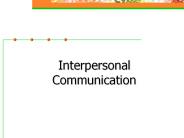Language and Nonverbal Communication - PowerPoint PPT Presentation
Title:
Language and Nonverbal Communication
Description:
... --clothing, jewelry Vocalics--vocal qualities Chronemics--time Proxemics--space Haptics--touch Types of Gestures Emblems--stand alone, ... – PowerPoint PPT presentation
Number of Views:144
Avg rating:3.0/5.0
Title: Language and Nonverbal Communication
1
Language and Nonverbal Communication
- Im sorry, but your position has been
redeployed
2
Initial Thoughts on Language
- There is no transparent language, it is all a
process of translation - Our understanding of language is hampered by the
container fallacy--we treat words as if they
contain meaning, in fact, people contain meanings - Meanings can be denotative or connotative
3
Jargon
- Defined as the language of a specialized
community--computer techs, pilots, skateboarders,
etc. - Advantages
- --promotes efficiency
- --promotes group cohesion
- Disadvantages
- --the problem of mystification
4
Euphemism
- defined as the intentional or unintentional use
of words to mask the potential emotional impact
of language - examples
- --death
- --losing your job
- potential impact--far less shared meaning
5
Verbal vs. Nonverbal
- Compared to Verbal Communication, Nonverbal is
- Less discrete
- More vulnerable to misunderstanding
- More likely to be context dependent
- More likely to contain the truth
6
Classes of Nonverbal Communication
- Kinesics--movement, generally
- Oculesics--eye movement
- Objectics (Artifacts)--clothing, jewelry
- Vocalics--vocal qualities
- Chronemics--time
- Proxemics--space
- Haptics--touch
7
Types of Gestures
- Emblems--stand alone, replacement
- Illustrators--additional message
- Regulators--affect verbal behavior
- Adaptors--stress indicators
8
Objectics
- Dress for Success and other lies
- Casual days and what they mean
- Policies on jewelry and piercings
- Cubicle decoration and nesting
9
Office Proxemics
- Personal space and distance
- Office size
- Office orientation
10
Chronemics and Vocalics
- Time as an arbitrary human creation
- Monochronic and polychronic cultures
- Vocal qualities and the latent message
- Speed, pitch, breathiness, nasality, etc.
11
Mid Term 1
- All lecture material is fair game!
- Chapters in Dodd 1, 2, 4, 8, 9, 11, 12, 13
- Any concept or theory discussed in Dodd in a
significant manner (separate section or bolded
item) is fair game, even if not discussed in
class. - Remember to bring a 2 pencil and 882 form
12
Sample Mid Term Q 1
- Which of the following theorists is most closely
associated with bureaucratic management theory? - a) Henri Fayol
- b) Douglas McGregor
- c) Katz and Kahn
- d) Max Weber
13
Sample Question 2
- Polysemy is most clearly connected with which
element of the contemporary communication model
described in class? - a) noise
- b) channel
- c) decoding
- d) none of the above
14
Sample Question 3
- The most appropriate leadership style for a group
task that is relatively simple, the group members
relatively unskilled and time for action limited
would be - a) laissez-faire
- b) democratic
- c) autocratic
- d) contingent
15
Sample Question 4
- Dodd uses a different name for the leadership
style that Burnett called laissez-faire. Dodd
called it - a) reluctant leadership
- b) leader-less leadership
- c) contingent leadership
- d) negligent leadership































